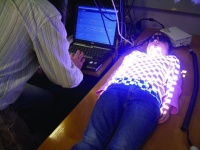
Cambridge start-up Pneumacare has been working with the MoD on a mobile version of its light-screening monitor, Pneumawatch, which it claims will provide better diagnosis of blast-lung injuries.
The device incorporates motion-capture technology used in the gaming and film industry, alongside a ’structured light’ approach, to provide detailed information about chest movement and lung function for patients.
’Current lung-monitoring technology is around 30-40 years old,’ explained Gareth Roberts, chief executive of Pneumacare. ’One of the things it finds difficult to pick up is a crushed chest, because often the chest is still moving. With our device you can determine whether it is the left or right side of the chest that is moving and detecting that difference is clinically very valuable.’
The Pneumawatch device works by shining a grid of light onto a patient’s chest. Multiple cameras are used to track certain points on the grid and observe distortions caused by movements of the chest. Once the data has been gathered from the cameras, algorithms are then used to reconstruct the surface in 3D, based on the extent of the distortions.
’Around 80 per cent of people who are caught in military explosions have some sort of blast-lung injury,’ said Roberts. ’When the pressure wave hits your face it goes straight down into the lungs and causes damage — and often that is the most complicated med
ical problem you have if you survive the initial explosion.’
Within a period of 12 to 24 hours, soldiers can develop acute lung reactions, often while being flown to a hospital or in an ambulance.
According to Roberts, Pneumawatch is the only device available that can effectively detect this injury while in transit.
The group is working on a lower-light-intensity version of the system so that it can be used covertly in a combat scenario. The group is also in talks to develop a Pneumawatch prototype certified for flight and military vehicles, and is hoping to produce a clinical version of the device this year.




Red Bull makes hydrogen fuel cell play with AVL
Many a true word spoken in jest. "<i><b>Surely EVs are the best solution for motor sports</b></i>?" Naturally, two electric motors demonstrably...